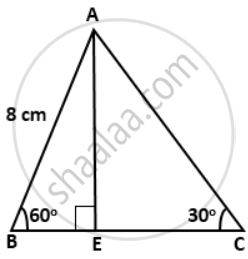Advertisements
Advertisements
प्रश्न
In the given figure, ∠B = 60°, ∠C = 30°, AB = 8 cm and BC = 24 cm. Find:
a. BE
b. AC
उत्तर

a. In right ΔAEB,
sin60° = `"AE"/"AB"`
⇒ `sqrt(3)/(2) = "AE"/(8)`
⇒ AE = `4sqrt(3)"cm"`
Now,
BE2
= AB2 - AE2
= `8^2 - (4sqrt(3))^2`
= 64 - 48
= 16
⇒ BE = 4cm
b. EC
= BC - BE
= 24 - 4
= 20cm
Now,
In right ΔAEC,
AC2
= AE2 + EC2
= `(4sqrt(3))^2 + 20^2`
= 48 + 400
= 448
⇒ AC = `8sqrt(7)"cm"`.
APPEARS IN
संबंधित प्रश्न
State for any acute angle θ whether tan θ increases or decreases as θ decreases.
Solve the following equation for A, if tan 3 A = 1
Solve for x : cos `(x)/(3) –1` = 0
Find the value of 'A', if 2cos 3A = 1
Solve for 'θ': `sin θ/(3)` = 1
If θ = 15°, find the value of: cos3θ - sin6θ + 3sin(5θ + 15°) - 2 tan23θ
In right-angled triangle ABC; ∠B = 90°. Find the magnitude of angle A, if:
a. AB is `sqrt(3)` times of BC.
B. BC is `sqrt(3)` times of BC.
Evaluate the following: `(sec32° cot26°)/(tan64° "cosec"58°)`
If sec2θ = cosec3θ, find the value of θ if it is known that both 2θ and 3θ are acute angles.
Prove the following: sin230° + cos230° = `(1)/(2)sec60°`
